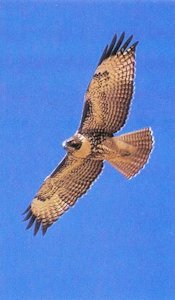
|
Soaring Flight of Land Birds Picture the majestic sight of a condor or a Red-tailed Hawk soaring in the spring or fall sky. With quills widely outstretched, it circles round, rising without a single wingbeat, as if lifted by some invisible hand, higher and higher until it disappears from view. The beautiful dance it seems to be performing is known as soaring. Soaring differs from gliding flight in that the bird does nor lose altitude and sometimes even climbs. When soaring, a bird uses no energy of its own; instead it depends on external forces called thermal currents -- rising masses of air that form over areas where the ground warms up rapidly. Thermal currents occur mostly above woodland clearings, cornfields, and even above some large towns. Thermal currents are caused when warm air moves upward and is replaced by colder air dropping from higher levels in the atmosphere. In temperate climates birds' use of thermal updrafts is somewhat restricted, but they sometimes soar to considerable heights over towns and other regions where hot air rises. Because the production of thermals depend upon solar radiation, these zones of rising air are not equally active at all times of the day and year. This is why soaring birds of prey are usually only seen circling in the air during sunny weather, and also why these birds are not usually seen before 9:30 or 10:00a.m.; it is only then that thermals become strong enough to bear them aloft. Since extended flapping flight would be far too exhausting for these birds, they remain at their roosts during the first few hours of the morning. |
| Red-tailed Hawk | |
|
Another kind of wind current soaring birds use in much the same way as they use thermals is called an obstruction current. Obstruction currents are produced when wind currents are deflected by mountains, cliffs, or tall buildings. The resulting updraft of air lifts birds to high altitudes, providing a base for further gliding. Soaring birds always have large and broad wings, and the ratio of their body weight to the size of the airfoils (their surface loading ratio) is low, Large airfoils of this type are ideal for soaring flight in thermals or in updrafts near mountainsides, but they are particularly poor for flapping flight. This is why, after takeoff, soaring land birds seek out the nearest updraft zone as quickly as possible and change to soaring flight as soon as they detect the supporting effect of rising air. At a certain height the rate of flow of the thermal current slackens and the bird switches to gliding flight and travel, losing height until it reaches the next updraft zone, which once more carries it upward. In this manner, soaring land birds can travel great distances without a single wingbeat. |
|